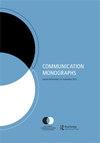信息诱导的信念变化中的心理差异:关于四种竞争模型的经验证据
IF 3.1
2区 文学
Q1 COMMUNICATION
引用次数: 1
摘要
摘要信息差异是指信息中所倡导的信念的位置与信息接收者最初信念的位置之间的差异,心理差异是接收者如何感知信息的差异。本研究测试了Fink等人的[(1983)。位置差异、心理差异和态度变化:一些数学模型的实验测试。通信专著,50(4),413–430]心理差异模型加上其他三个模型,以确定心理差异是否影响信息的重量、信息的量表值,或两者兼有。这些模型在一项实验中进行了测试,该实验以3(高、中、低信息量表值)处理了心理差异 × 3(宽视角与中等视角与窄视角)受试者之间的设计(N = 448)。最初的Fink等人的模型得到了最多的支持。研究结果有助于解释心理过程是如何导致信念改变的。本文章由计算机程序翻译,如有差异,请以英文原文为准。
Psychological discrepancy in message-induced belief change: Empirical evidence regarding four competing models
ABSTRACT Message discrepancy is the difference between the position of an advocated belief in a message and the position of a message receiver’s initial belief, and psychological discrepancy is how the message’s discrepancy is perceived by the receiver. The present study tested Fink et al.’s [(1983). Positional discrepancy, psychological discrepancy, and attitude change: Experimental tests of some mathematical models. Communication Monographs, 50(4), 413–430] psychological discrepancy model plus three other models to determine whether psychological discrepancy affects the weight of a message, the scale value of the message, neither, or both. These models were tested in an experiment that manipulated psychological discrepancy with a 3 (high vs. moderate vs. low message scale value) × 3 (wide vs. moderate vs. narrow perspective) between-subjects design (N = 448). The original Fink et al. model was the most supported. The results help explain how psychological processes bring about belief change.
求助全文
通过发布文献求助,成功后即可免费获取论文全文。
去求助
来源期刊

Communication Monographs
COMMUNICATION-
CiteScore
5.40
自引率
0.00%
发文量
12
期刊介绍:
Communication Monographs, published in March, June, September & December, reports original, theoretically grounded research dealing with human symbolic exchange across the broad spectrum of interpersonal, group, organizational, cultural and mediated contexts in which such activities occur. The scholarship reflects diverse modes of inquiry and methodologies that bear on the ways in which communication is shaped and functions in human interaction. The journal endeavours to publish the highest quality communication social science manuscripts that are grounded theoretically. The manuscripts aim to expand, qualify or integrate existing theory or additionally advance new theory. The journal is not restricted to particular theoretical or methodological perspectives.
 求助内容:
求助内容: 应助结果提醒方式:
应助结果提醒方式:


